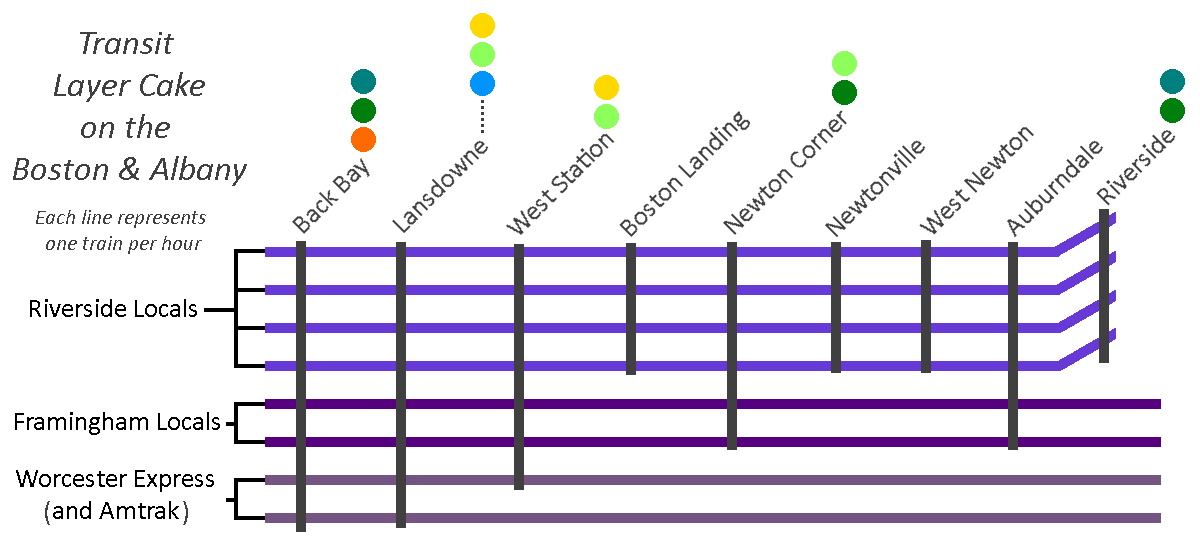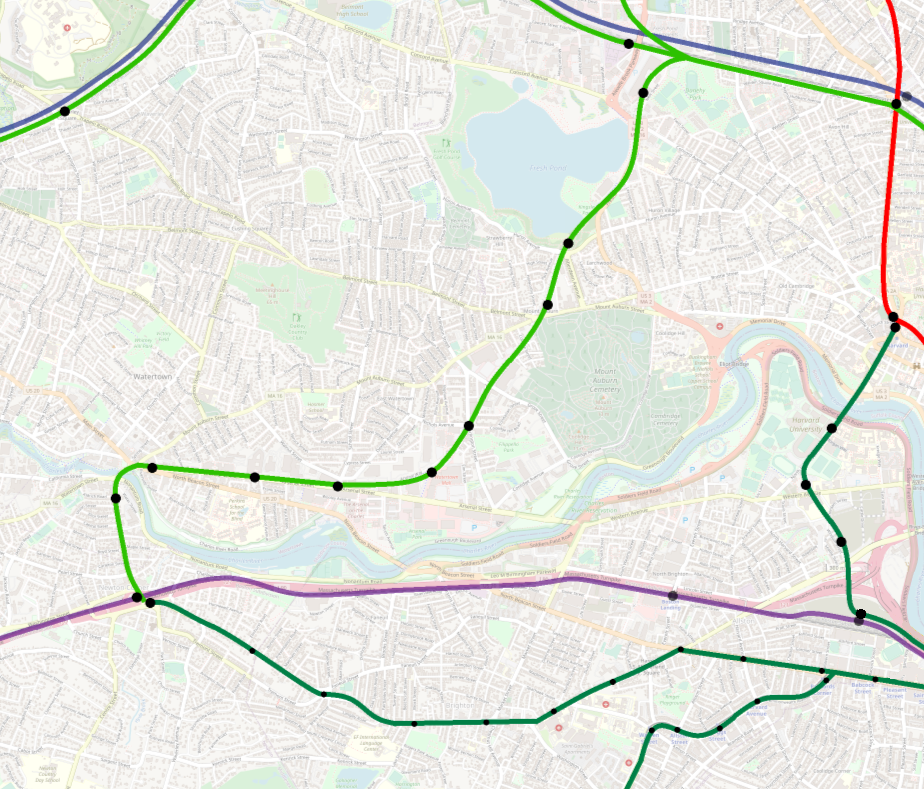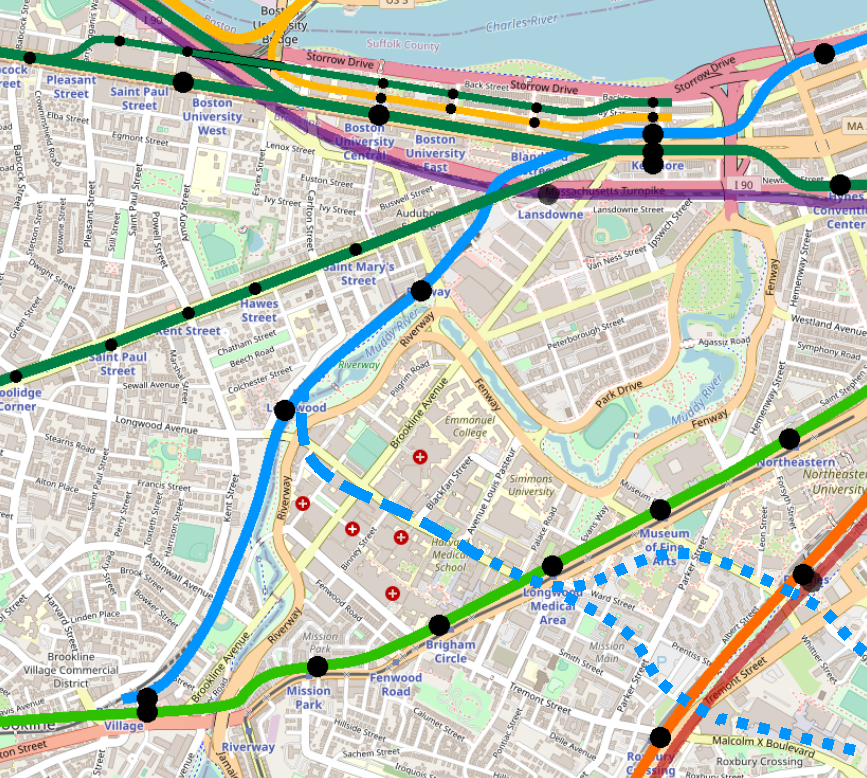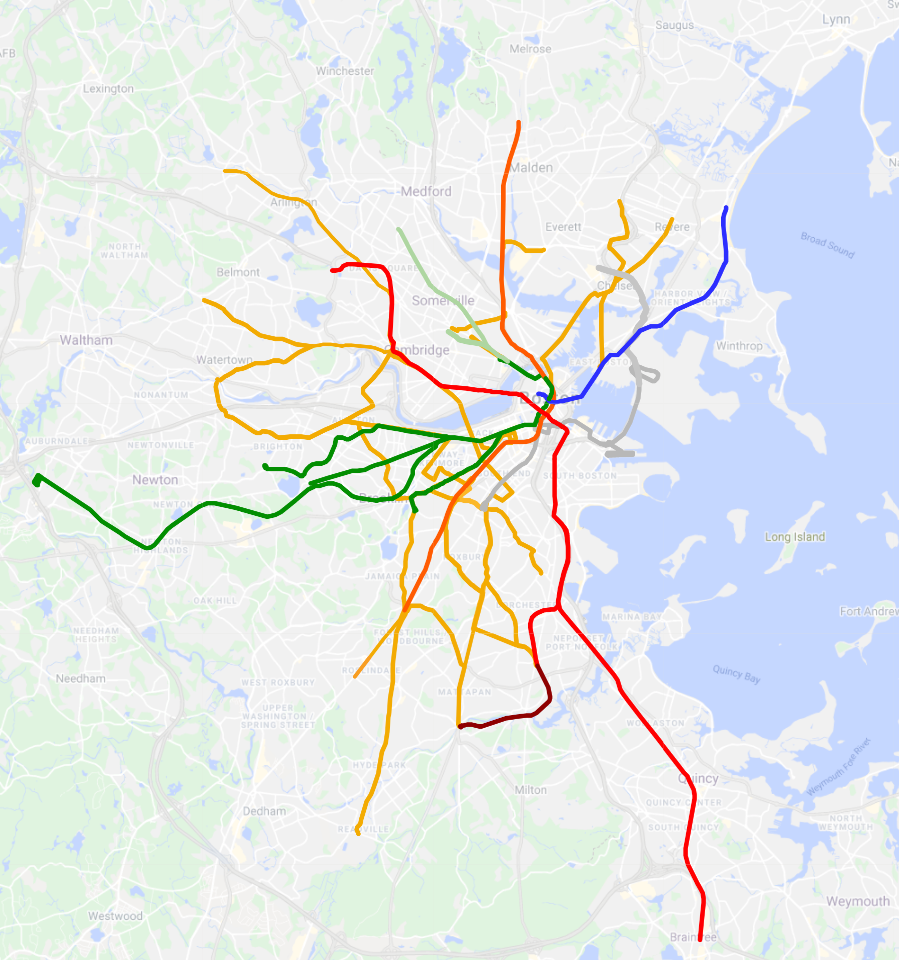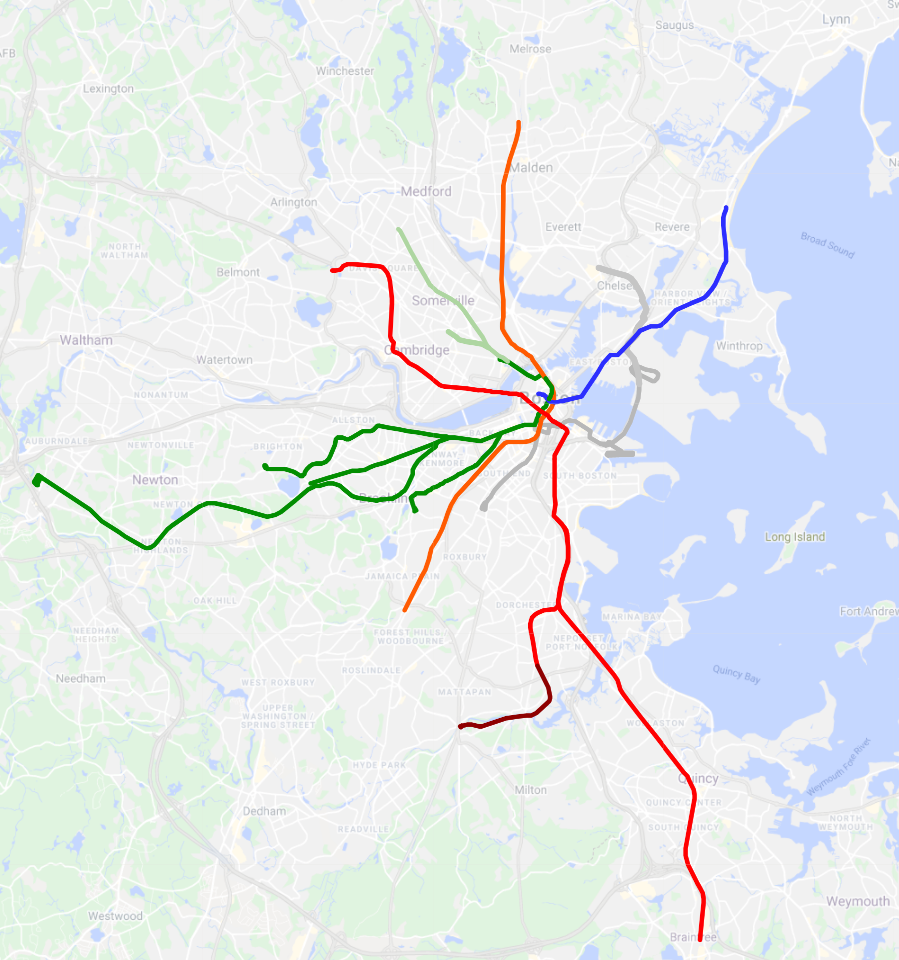When I was a kid, I wanted to send branches everywhere. As a child, it was an easy concept to understand — I knew that branches came (like the Braintree or Riverside branches) and that branches went away (like Watertown), and if the Green Line used to have five branches, maybe it could have six or seven or eight! And if the Green Line could have eight branches, why couldn’t the Orange Line?
Obviously, with age has come a modicum of learned wisdom; I stopped drawing branches everywhere and tried to focus on only sending branches where train service actually was reasonable. But there is more to the picture than that.
It is tempting to think of subway branches like roads. If you build a new road, it means that more places are connected. Providence and Hartford don’t have an interstate highway between them — you have to drive north or south first and pick up Route 84 or Route 95, and then head west. It takes longer than it would if there were an interstate directly between them, which is why you will occasionally hear proposals for one. Two disconnected places ought to have a connection between them.
Rail systems don’t work like that most of the time (and actually road systems don’t either, but that’s a different topic).
There actually is a surprising amount to discuss on this topic! Here are some rules of thumb:
Two branches max
For most systems, do not give an HRT/subway line more than 2 branches. A light rail line, or a commuter/regional rail line, can probably take more, but keep in mind the other rules of thumb below.
One evening I decided to jump down this rabbit hole and did a cursory review of pretty much every heavy rail subway system in the world. Almost none had HRT lines with more than 2 branches. Most of the exceptions were themselves exceptional systems, such as BART or London’s Metropolitan Line, both “subway” lines that act more like commuter rail lines, especially along their branches.
Consider frequencies
Branches have low frequencies, trunks have high frequencies. Trunks should only branch once they are far enough from the urban core that lower frequencies will be feasible.
Most transit systems in North America have a “full-build reach” (even if hypothetical) of a 10 mile radius from the center. Your trunk shouldn’t branch too close to downtown; every city will be different, but in general you’ll want your trunk to branch no closer than 5 miles to the core. If you need to branch closer to the core, you should try to create a second trunk line.
Remember that branching frequencies are almost always a hard-and-fast math problem: If your trunk line can take x trains per hour max, then two branches can each feed no more than 50% of x. That is often going to be enough to knock a “high-frequency” trunk service into a “mid-frequency tier” on the branches. As such, it’s worth conceptualizing a branch as something less than a “full” rapid transit line.
In the diagram below, note how the trunk line has a high frequency of 4 minute headways via 15 trains per hour, but that splitting it up into three branches very quickly drops frequencies to 12 minutes on each branch.
Read more about decreasing branch frequencies in my follow-up post on this topic.
Trunk line capacity should be your starting point
It’s important to recognize that branches are (usually) a game of subtraction, not addition. Your trunk line provides the pool of trains that you can send out to multiple branches. Unless you know that the trunk line is under capacity, you should assume that they are shoveling through as many trains as they possibly can, and can’t add more. So you need to think about redirecting the existing pool of trains, which is why this is a game of subtraction and not addition.
Note that I said this is usually a subtraction game – some newer/younger rail systems will not be at capacity. When that is the case, a branch proposal can work in your favor: proposing the addition of a second mid-capacity branch can combine with the existing mid-capacity service to create high-capacity service in the core (where presumably demand will be higher). Especially in newer metro systems, there may not be sufficient existing demand to justify the capital expenses of expanding the fleet to increase service in the core; adding a branch can broaden your revenue base, and enable the purchase of enough vehicles to run high-frequencies in the core. (Sometimes – these calculations are always going to be complicated.)
Look for short-turn services (and over-capacity extremities)
Transit agencies are incentivized not to run extraneous services. The further out from the core, the lower the demand for service (very much theoretically, but I digress). One solution agencies use are short-turn services, in which some fraction of vehicles do not run the full-length of the route. Sometimes this is done to reduce the number of near-empty vehicles running on the outskirts of the line, and sometimes this is done in order to increase the reliability of service on the inner sections of the line (and sometimes both). Short-turns are very common on bus routes, but do have their role in rail transit as well.
If your trunkline has an existing short-turn service, that is a very strong jumping-off point for a new branch: it points to a confirmed high-frequency trunk/mid-frequency branch demand model, and it doesn’t require additional capacity to be freed up in your trunk, since you aren’t trying to funnel a greater number of trains per hour through. (You will still need to expand your fleet size to maintain existing frequencies, although you may be able to adjust frequencies elsewhere in the network to account for the longer trips your short-turn services will now be taking on the branch).
But be careful – this technique works well if the short-turn is intended to avoid excess capacity on the extremities of the existing service. If the short-turn is intended instead to increase reliability within the core, then extending those short-turns out onto a new branch may jeopardize that reliability. And make sure to take note of the pitfalls of junctions, below.
Be cautious with reverse branching
Be cautious with reverse-branching, which is when a transit service splits into multiple branches going in to the city, rather than going out. (SEPTA’s Broad-Ridge Spur is a good example of this on-paper. In practice, it’s actually a little more complicated, but that’s a post for another time.)
http://www.septa.org/maps/system/
Recall what we went through above: branches are lower frequency than trunks. Reverse-branching into an urban core thus means you are reducing frequency precisely in the area you need it most.
Note that I say “be cautious,” not “avoid.” I think that one of the major values of crayon maps is that they sometimes value creativity over feasibility. Reverse-branching is usually more creative than it is feasible, but sometimes it sparks good follow-up ideas. So, I wouldn’t forbid it as a hard-and-fast rule, but it’s good to be aware of its drawbacks.
Junctions are complicated
Junctions where branches come together will always have one of two drawbacks, so be careful where you put them:
If a level junction is used, then you will have capacity limits and sometimes delays, as trains need to wait for each other to cross, and may need to leave a whole signal block free (i.e. the train may not be able to wait right at the junction like a car at an intersection, but may need to be hundreds or thousands of feet away).
A flying junction avoids those problems and should be the standard for any new rapid transit junction. However, flying junctions are much more expensive, and also take up more space — horizontally and vertically — than level junctions. So, as with all things, it’s a trade-off between cost and quality of service. If you want your proposal to be taken seriously, make sure your proposal is ambitious enough to merit building the flying junction.
In conclusion, branches are not your friend
Branches are not the friend of the crayon-mapper. They look great on paper but require a lot of careful planning to be done well; when done poorly, they can be actively detrimental to the individual branches and the system overall. If you really want to use them on a subway network:
- No more than two branches
- Aim to branch at least 5 miles from the core
- Look for segments where there already is reduced service (short-turns) or reduced demand for service (lower density)
- If both branches demand full-frequency service, then both branches warrant their own trunklines through the core: i.e. they shouldn’t be branches, but should be separate lines
Post-script on LRT, BRT and mainline rail
All of the dynamics I describe here hold true on other modes of service. However, the cost-benefit calculations work out a little differently because there are different standards for these modes.
LRT
For the most part, LRT is going to have the same struggles as an HRT subway would. The main differences are all knock-on effects of light rail’s shorter and more nimble rolling stock. Shorter trains makes it easier to “fudge” capacity in a trunk line, with multiple trains stopping in a single station at once, and shorter signal blocks allowing trains to run closer together. The shorter signal blocks also mean that flat junctions – while still disruptive – can be mildly less problematic.
LRT also – by virtue of its lower capacity – is sometimes a better fit for serving lower-density regions, which can sometimes mean that the frequency cost of more than two branches is more manageable, especially if combined with a higher frequency on the trunk than you could achieve with larger trains.
Boston and Philadelphia both run a scheduled 40 light rail trains per hour through their tunnels (Philly apparently swings even more than that), with four and five branches respectively. San Francisco runs at a lower frequency (I think) in the Muni Metro subway, also with five branches. All three of these systems are plagued with reliability and other issues. (Muni recently tried to redirect two of its branches out of the subway, but now has returned them to the tunnel). That isn’t to say that these systems can’t be improved, nor am I denying benefits to their approaches. But it’s probably best to think of these as the exceptions which prove the rules.
BRT
BRT comes in lots of flavors, some of which are more amenable to branches than others. Christof Spieler gave an excellent presentation at TransitCon 2022 on the varieties of BRT, and discussed some of the pros and cons of branching on each. In short, I’d say that the more you want your BRT line to act like a subway line, the more you should follow the same rules about branching.
Mainline rail
Mainline rail faces all of the same dynamics I outlined above. The major difference is that the costs of branching don’t always end up being “disqualifying.” If you take a 20tph rapid transit line and give it 10 branches, each branch will get 30 minute headways, which no longer is “rapid transit.” But if you give a 20tph commuter rail line 10 branches, the 30-minute headways on each branch may be perfectly reasonable. The same dynamic is at play — it’s just that the requirements are different and therefore the costs are more acceptable.
On the other hand, some dynamics remain equally if not more problematic. Junctions, for example, will still be disruptive if built flat and costly if built flying. And reverse branching’s impact may be felt even more acutely: many American commuter rail lines run once per hour; split those between two downtown terminals – we’ll call them “Northtown” and “Southtown” –, and commuters now have to wait two hours between trains, which reduces flexibility for riders and may have an overall chilling effect on ridership on both branches.
Consider this fictional system below:
At first glance, it looks like a relatively robust commuter rail network. Each suburb sees 30-minute headways, and that segment between Newtown and Riveredge sees rapid transit-frequencies of 7.5 minutes. And every community sees direct service to both Northtown and Southtown.
But most commuters don’t care about going to two different workplaces – their destination is the same everyday. Let’s look at what the network looks like for a Northtown commuter:
This paints a significantly different picture. Most suburbs are reduced to hourly service, and the turn-up-and-go frequencies at Newtown are gone.
(To be fair, in this example, most American cities would be thrilled to see commuter rail service at this level – hourly commuter rail is nothing to sneeze at. But I’m keeping the numbers simple to keep the math simple; if most cities start with hourly commuter rail, then reverse branching drops the effective frequency of each branch down to every two hours, which is pretty rough. You get the idea.)
Instead of a robust trunk-and-branch network, reverse-branching reduces this network into two significantly diluted networks operating in parallel.



